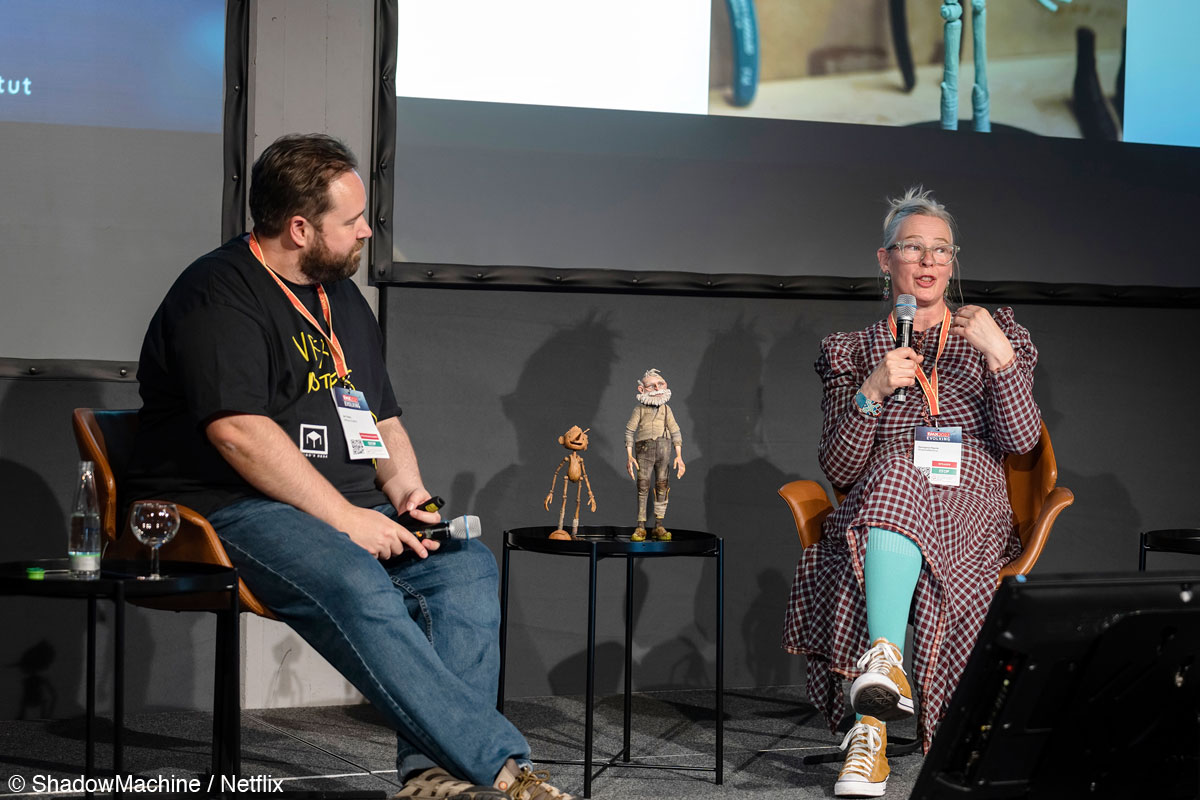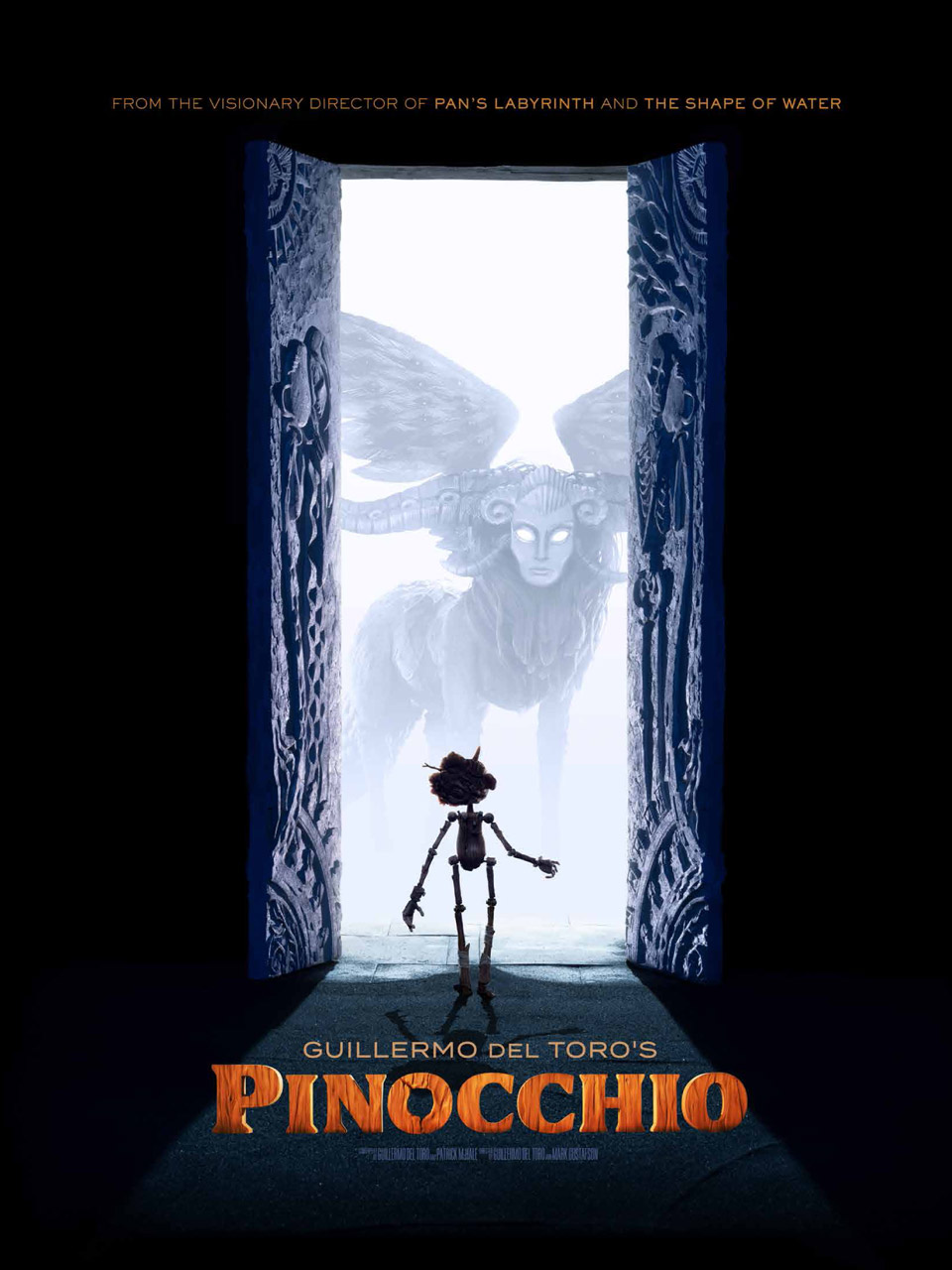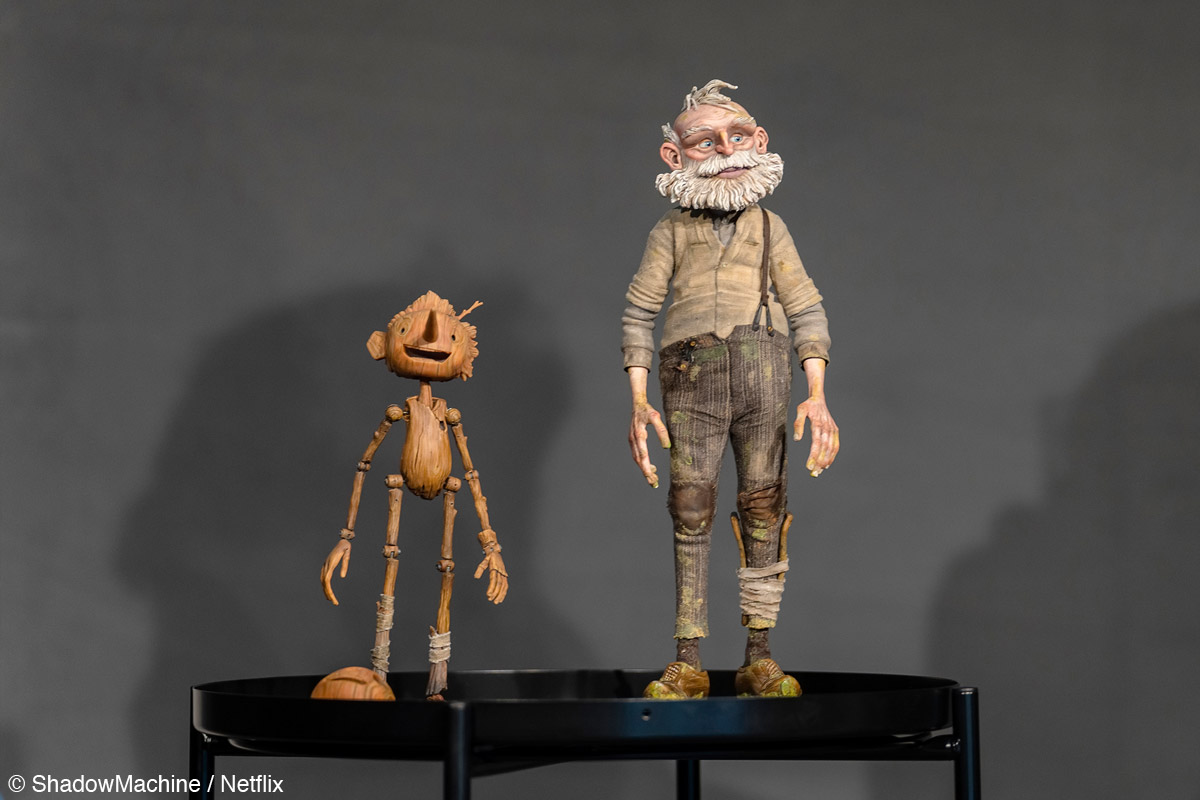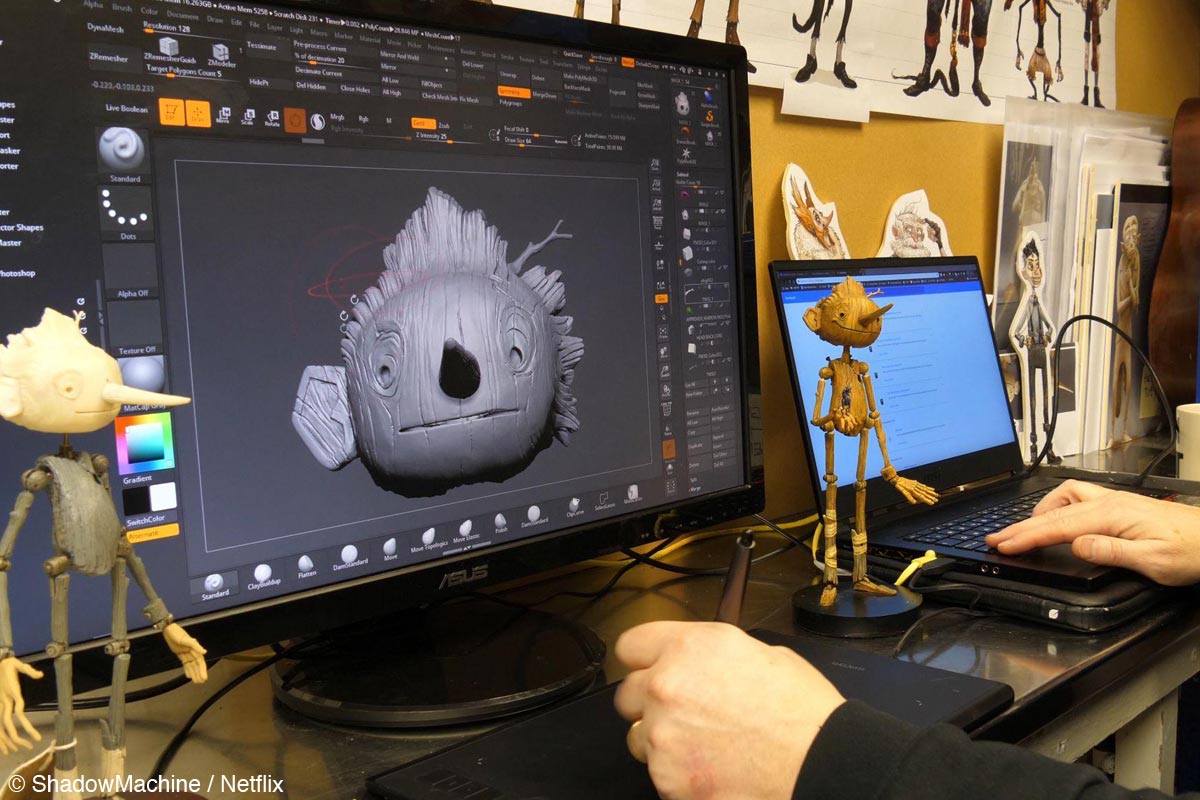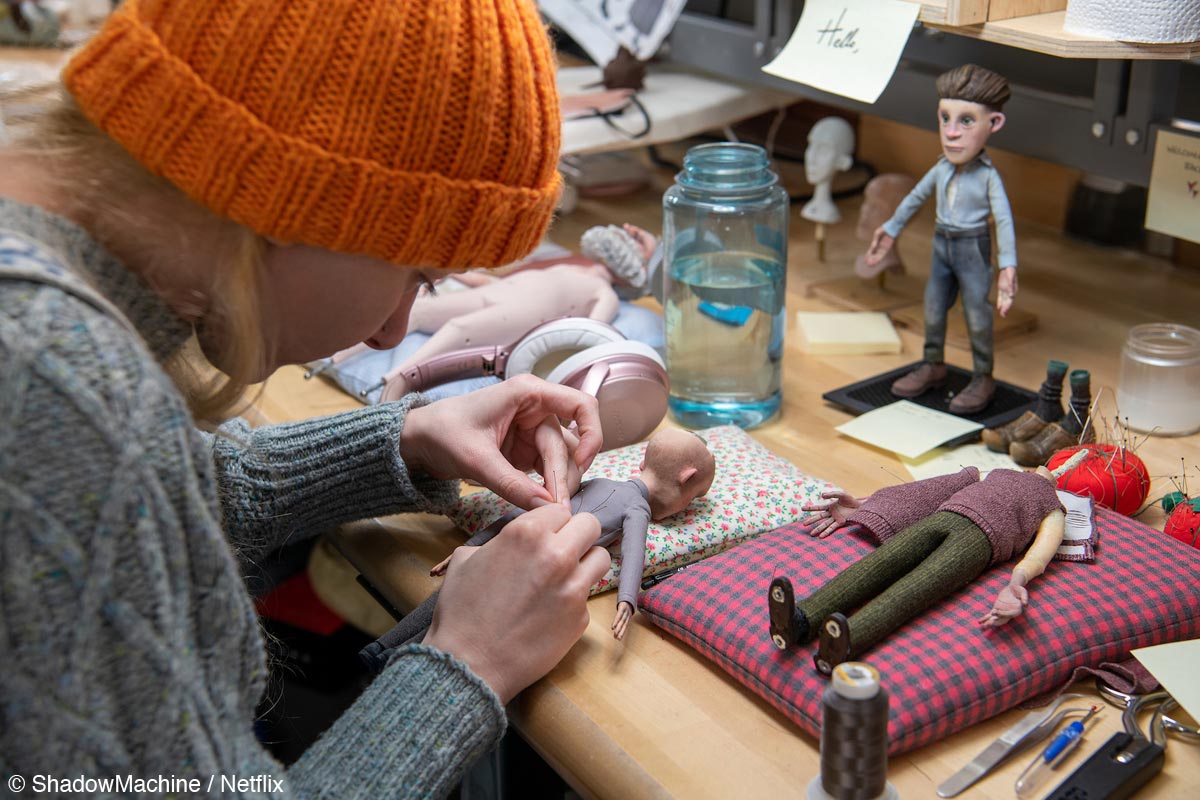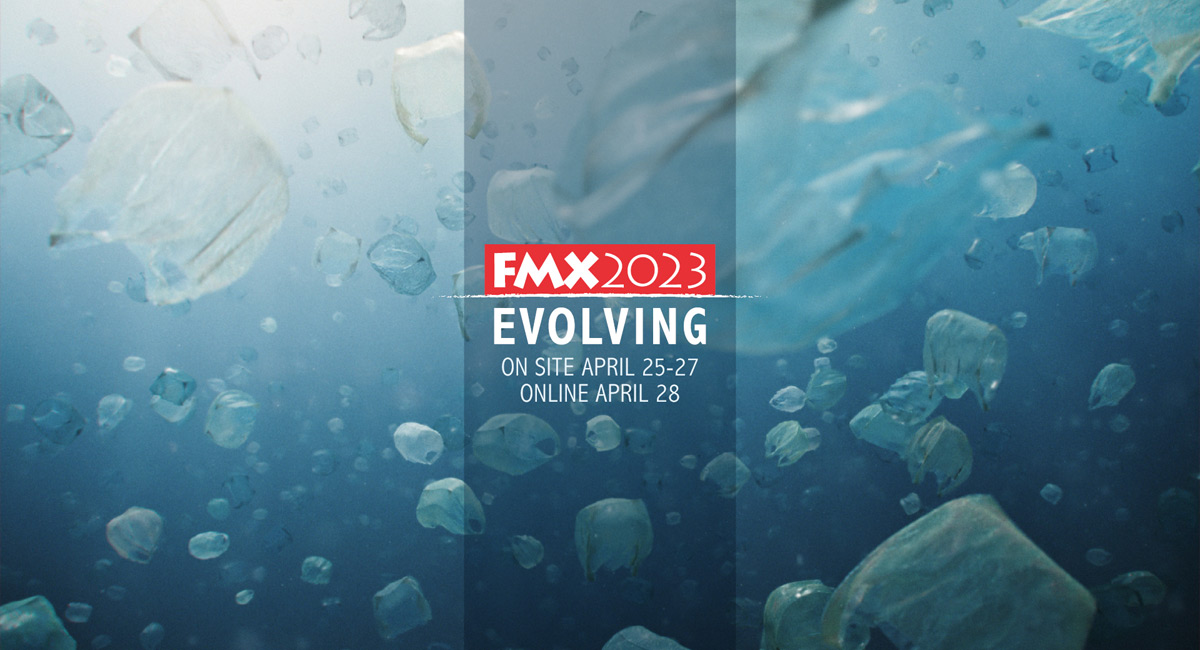FMX 2023, one of the most important international conferences on animation, effects, interactive and immersive media, had a valuable session on character fabrication for stop-motion films with Georgina Hayns, the Puppet Fabrication Supervisor at Shadow Machine, a multi-award-winning American animation company famous for Robot Chicken and BoJack Horseman.
The session is a comprehensive talk on the creation of characters for the Oscar and Golden Globe winning stop-motion animated musical film Guillermo Del Toro’s Pinocchio that she recently worked as one of the directors of character fabrication together with Ian MacKinnon and Peter Saunders, the two co-founders of Mackinnon & Saunders Ltd.
We interviewed Georgina on some key points of her work for Guillermo Del Toro’s Pinocchio and her insightful story behind her bright career as a world-leading puppet creator.
Interview with Georgina Hayns
Hideki Nagaishi (HN): I would like to ask you several questions on Guillermo Del Toro’s Pinocchio. Firstly, how did you take part in the film project Guillermo Del Toro’s Pinocchio?
Georgina Hayns: I was the creave director of character fabrication at Shadow Machine, essentially working with a team of puppet makers going from the initial 2D character design through to the completion of a stop-motion puppet version of that character.
I worked with some amazing people across several countries for the film; in Portland, Oregon, USA, at Shadow Machine, we had about 50 to 60 artists, engineers and craftspeople working on the team. We were also working alongside Mackinnon & Saunders, which is, interestingly, the company that trained me. I grew up with them in the animation industry in England before I came to the USA. And there was also a very small group in Guadalajara, Mexico because Guillermo really wanted a part of a scene of the film to be shot in his home city of Guadalajara. There’s an amazing animation culture and scene there, and he’s been very supportive of that group of people. So, from the beginning of the film it was his dream for them to be involved.
So, what is my day-to-day task? At the beginning of the film, I compile all of the crucial information on the characters in the film: I need to get the performance notes from the director of animation, and then find out what is the look and style from the production designer. It’s about bringing this information and the team of artists together so that everybody has everything they need to start constructing a puppet, which can take from three months to a year depending on the sophistication level and what’s needed of that puppet. So, this was going on in these multiple studios across the world, and I was creatively overseeing all three studios to make sure that the puppets felt like they were all in the same world.
HN: Could you please explain briefly about the role of the directors of character fabrication in the film project? What were your creave responsibilities for the film and what did you take care in the most to maximize your creative contribution to the film?
Georgina Hayns: The main thing that I’m keeping an eye on every day is having the characters belong in the world and that they belong next to each other, so it’s understanding the visual language of the film and the visual language of the character designs, and making sure that doesn’t get lost from that first maquette (done from 2D drawings) to the finished puppet. Since we go through many different iterations, we go from a drawing to clay, clay to a stripped-down naked puppet and then we dress it and paint it. There’s a lot of areas that it goes through and there’s a lot of people involved where visually it might go off-style. So, I’m keeping everything on-style.
The other part of my job is more technical. It is making sure all the characters can perform and act to the needs of the story and the needs of the animators. I brainstorm with all the fabrication departments how we’re going to build the puppets and once we have a build outline we then discuss this with the animation department.
HN: Could you please let us know what were some of the puppet creations during the project that particularly stood out for you, and why?
Georgina Hayns: I think the most exciting puppet that was worked on in England at Mackinnon & Saunders was Pinocchio. The thing with Pinocchio is that he’s a wooden boy so that, unlike all of the other characters in the film that are human, he had a very distinctive look and we were able to actually have his look inspire the animation technique we used for him. We decided to do his faces with coloured 3D printed replacement parts. I think we made about 800 different face shapes for Pinocchio, which sounds like a lot but it’s a lot less than some other films that have been done. We also experimented with 3D printed metal parts, so we can screw into it, we can attach other metal parts, but then we can also get the detail of the wood grain on the outside of the 3D metal printed parts. His body is so stick-like and small, frail and fragile looking, and these puppets need to withstand a year of filming. In fact, sometimes 2-3 years of filming. It was a great challenge and a great puppet build. – We would literally be on Zoom and Google Hangouts every day across the ocean, making sure that the puppet was technically working for the animation team in Portland, but also aesthetically – on style for what Guillermo wanted.
A highlight of our build in Portland were the 3 creatures, the Dogfish, I would say, was – a real highlight of our creature builds. We decided to embrace everything we’ve ever learned in stop-motion about puppet making. And we went back to the good old days: we used foam latex.
It’s a large puppet, about 4 foot long by about 2 foot tall, with a fully articulated metal armature. We built it to a scale that an animator could handle. If we had cast it with a silicone skin it would have weighed so much and we would have had to re-engineer our rigging to hold the puppet. Therefore, we decided to cast it in foam latex and the foam latex lent itself visually to the look of a creature that lives at the bottom of the ocean, and that helped both practically and aesthetically.
In Guadalajara, they made all of the black rabbit characters and, to be quite honest, their designs were one of my favourites! The designs are stripped down to the skeleton of a rabbit but they wear their own skins as coats: the only part of them that’s almost rabbit-like is the head. The head is silicone and the body is cast aluminium with a combination of hard and so limbs. The aluminium rib cage was a great solution as it allowed for the weight restrictions. If we had cast them in steel, the skeletal rib cage would have been so heavy that the ankles would have given way all the me.
HN: Were there any creative challenges unique to the film?
Georgina Hayns: I would say the most challenging element in the film for the puppet department were the human characters’ head mechanics. Guillermo wanted the human characters to have a designed, lifelike appearance. So, trying to get something as believable as a human but in a designed world is quite challenging.
We decided to do all of the human characters with head mechanics, unlike Pinocchio where we used replacements, they were done with the silicone skin sitting over a skull with articulated ball and socket joints in the skull. Sometimes some of the characters have gears which were accessed through the ears to make the characters smile: they had little cables attached to the corners of their mouths, connected to a gear inside their head, and when you turn an Allen key it would pull the cable up to smile, or turn the Allen key down and the cable would then pull a frown on the face. They’re highly sophisticated, almost like Swiss watches underneath a silicone external skin.
The biggest challenge on those heads was the eye area. Guillermo wanted the eyes to be lifelike. We did ball and socket eyes. The blinks were a separate part, and the socket itself was an engineered part that we use the 3D printer for. The movement of an eyebrow is articulated by a lever which is attached to a ball socket joint behind the eye. The silicone skin is attached to a very small edge above the eye which holds the skin in place, The eye brow would constantly tear the skin away from the eye socket creating gaps around the eyes which made the faces look like masks rather than skin. There was a lot of time spent at the beginning of the film designing and testing eye cups and eyebrow interaction. We solved many of the issues at this time but the eyes continued to be problematic throughout the film.
HN: Now, I want to ask you a few questions about your job in creating puppets for stop-motion films, and about your career in general. Could you please let us know why you’ve decided to become a puppet creator and what are the fun, rewarding, and attractive aspects of the job for you?
Georgina Hayns: I did not really decide to become a puppet creator. My career in stop motion evolved from Designing and fabricating Dolls.
After school I attended a two-year general art and design course in which I was introduced to many creative skills beyond Drawing, sculpting and painting.
At the end of the two years, I was utterly confused as to what I wanted to do with all of these skills. But at the same time as this, I was collecting old dolls and I was repairing, restoring, and making my own dolls. Through my interest in doll making I realised Puppets used the same methods and techniques. I started to research many different forms of puppetry across the world, shadow puppetry, marionettes, hand puppets, and interestingly the last one I really found out about was stop-motion. The first thing that really blew my mind was watching Jim Henson’s The Dark Crystal. Those were live-action puppets but made with all the same materials that we’re making our stop-motion puppets with.
I went to Manchester Polytechnic to do a degree in film and TV. I was inspired to do this course when visiting the campus and seeing the work of one of the past students. He also built puppets getting a work placement at a local animation studio called Cosgrove Hall Productions. It just so happens that they were making not only 2D drawn animated cartoons but also stop-motion cartoons for British kids TV. I followed in his footsteps and got a work placement at the studio a couple of years later. They invited me back to do an apprenticeship in my second and third year and when I left college, I was given a job there. The puppet department at Cosgrove Hall Productions eventually became Mackinnon & Saunders.
I think that the thing that attracted me to Stop-Motion puppet making, is that it uses every part of your brain. Part of it is working out how you are technically going to make this inanimate object be able to act and perform and come to life frame-by-frame. And the other part of it is making sure it keeps on style to the look of whatever show you’re on.. So, I would say that is what’s kept me interested and passionate about stop-motion animated puppet making for at least 30 years.
HN: I’m interested in how you could build your brilliant career. In brief, could you let us know your journey towards becoming one of the most successful puppet creators in the world? What do you think was the biggest turning point in your career so far?
Georgina Hayns: Like most people starting out in the world I started at the bottom and slowly worked my way up through stop-motion. The first thing I made was a prop daffodil for The River Bank – The Wind in the Willows. And then I got to make a sack to go over the head of Toad in The Wind in the Willows. Then I made some of the static resin-cast background characters in The Fool of the World and the Flying Ship. I was always willing and able to take on anything that was asked of me. I would sculpt if need be. I would paint if need be. I would make armatures and I enjoyed it. So, I was happy with my work.
Tim Burton’s Corpse Bride, the final project I worked with Mackinnon & Saunders on in England, was the first full-length stop-motion feature film I’d worked on. I worked on building the puppets in Manchester and then went down to London to be part of the maintenance team keeping the puppets going with the animators, I met a lot of animators and puppet makers from all over the world. At the end of that, I got a phone call asking whether I would go for an interview for the head of puppets on the feature film Coraline in Portland, Oregon. This was the birth of LAIKA Studios. I was terrified leaving my whole world behind in England. But it was an opportunity I could not turn down! I felt like it was time. So, I took the leap and it was an incredible turning point.
When I got there, I was literally the first person on the crew who had anything to do with puppet-making. So, I hired a crew of artists and craftspeople to build the puppets from all over the world. It was an amazing experience. You blink and suddenly you’ve worked on four or five feature films all at the same studio. And you’ve been part of a studio that has pushed the art and technology of Stop-Motion to new levels!
HN: I would like to hear some tips on becoming a fully qualified puppet fabrication supervisor or director. What kind of things do you always take care of in the process of creating puppets? And what kind of mindset is important as your position?
Georgina Hayns: The mindset is about positivity. Never thinking this can’t be done. You’re constantly being presented with designs and ideas and requests that seem like they’re impossible at times, but it’s seeing those as a challenge rather than a burden. And overcoming the challenge and then finding fun in the challenge.
In the role of a puppet fabrication supervisor, which is the same role as a director of character fabrication, it is all about good communication and having understanding and knowledge. I think it’s really important that you’ve been on the studio floor and you know what your team must do. And having a good understanding of the process is critical, an understanding of the production side of puppet making. For example, how do you schedule making one puppet and then how do you schedule making hundreds of puppets over maybe one to two years?
It’s good to have an understanding of that, but it’s also good to accept that you’re going to need help. On all of the big projects that I’ve worked on, I’ve always had a production manager working alongside me. They deal with all the things that you don’t have time to deal with because you’re keeping your team of people on task, on style, and making sure they’re all communicating and making the puppets. It is important that you understand those needs and that you’ve got to work with the team around you, not only your puppet-making team, but also the producers, the directors, the animators, etc. So, I would say that’s the most important thing; Get the right people around you to support you.
I think making puppets is a joy and love of artistry, craft, and engineering. It’s a very particular mindset, and when I’m looking for puppet makers to hire, I don’t always hire people who have been to animation school but people who have done ceramics or done jewellery or studied theatre, because they’ve got an eye for detail. Detail is very important because everything we work on is one-sixth scale of human scale. Everything is shrunk down and yet it’s going to be blown up on the big screen. So, if they have a really high level of craftsmanship and an eye for detail, it doesn’t really matter what area they are in because we can train the people in to stop-motion if they have the raw talent. Then it’s not going to take much to get them working in the stop-motion industry.


